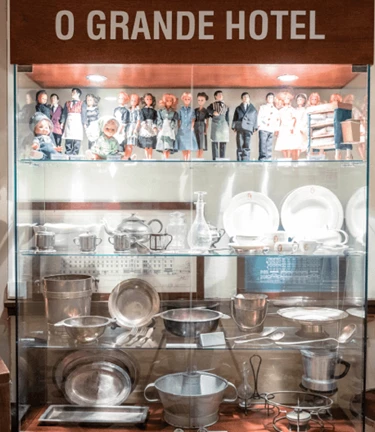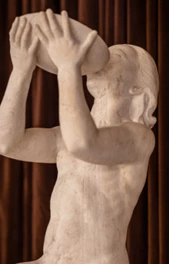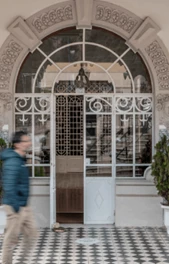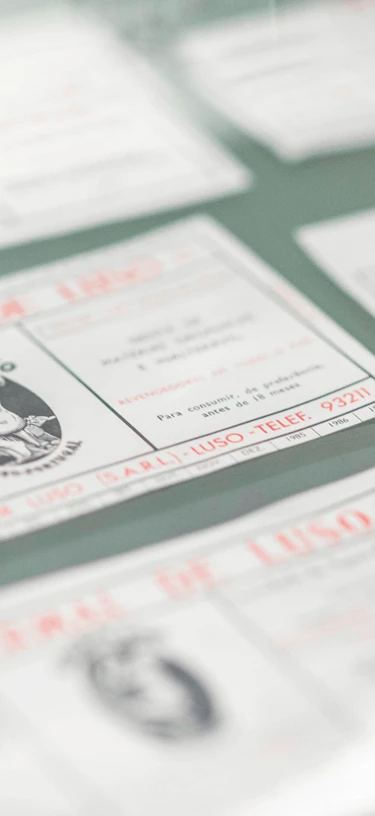
Museum
Museum
The entire Casino gallery space is occupied by the Museum Collection of Sociedade Água de Luso, which includes the history of Água Mineral Natural de Luso, the history of Cruzeiro spring water, the Thermal Spa of Luso and Grande Hotel de Luso, which were part of the former Sociedade Água de Luso and, currently, part of Sociedade Central de Cerevjas e Bebidas.
On display are emblematic pieces of the Company's history, representing the historical and cultural heritage of the time.
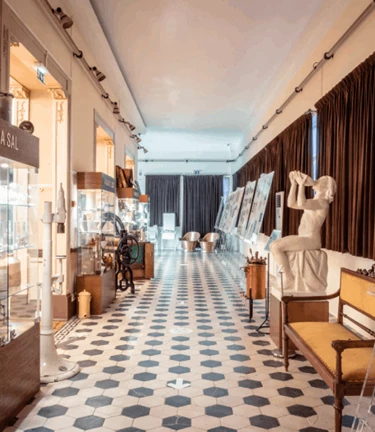
Água de Luso
An exceptional resource, Água de Luso has its spring in Serra do Bussaco. It originates from the infiltration of rainwater into the rocks. The underground route is very long and slow and lasts about 1000 years at a depth of hundreds of meters. This is what grants it its original purity, free of any chemical treatment.
Água de Luso was first recognized for its thermal properties due to its temperature of 28º and CO2, which lead to the foundation of Sociedade para o Melhoramento dos Banhos de Luso on August 25, 1852.
In 1894, Dr. Manuel Bento de Sousa is the first doctor to recognize that Água Termal de Luso is also an "excellent table water". "(...) Anyway because Luso's thermal water is excellent for internal use, it has a long and prosperous future".
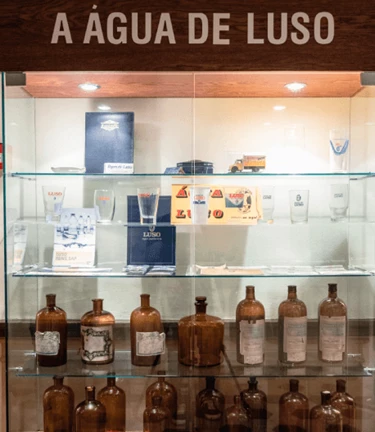
This is due to the fact that after being captured, stored and bottled, the thermal properties of Água de Luso dissipate and, therefore, can be consumed by all, without any restrictions.
Also in 1894, when Água de Luso is bottled for the first time close to Termas do Luso in the center of the village, the company takes on the name of Sociedade Água de Luso, SARL.
In 1903, the renowned French chemist, Charles Lepierre, performed a bacteriological test of Água de Luso, classifying it as "Extremely Pure" or "Very Pure Water". Charles Lepierre (1867-1945) was a French chemist who developed most of his scientific and professional activity working for Portugal.
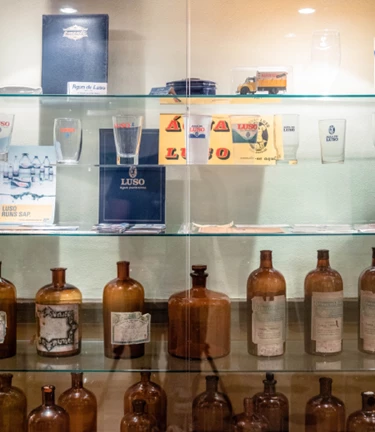
Água do Cruzeiro
In industrial terms, the 50’s began under the sign of expansion: Sociedade da Água de Luso, S.A. buys Refrigerantes Cruzeiro and Quinta do Cruzeiro located in the municipality of Vacariça.
The decision taken by the management of Sociedade Água de Luso to buy Quinta do Cruzeiro and its water and soft drinks businesses, respectively, was based on two very different objectives: focus in the soft drinks’ market and meet market needs with its spring water during the high season. Soft drinks’ consumption was a well-imbedded custom and tradition among families in Bairrada (who had a successful neighboring brand called Refrigerantes Bussaco). Also, Sociedade Água de Luso already had experience in producing (1916) soft drinks made with Água de Luso.
Água do Cruzeiro is a spring water, with about 212mg/l of total mineralization, rich in magnesium, calcium and bicarbonate. It is captured in an aquifer on the slope of Serra do Bussaco at about 120m altitude and 5 km from the village of Luso.

Sociedade Água de Luso
The first sale of Água Termal de Luso was reported in 1894.Água Termal de Luso is sold in 1-litre glass bottles and 10-litre and 20-litre straw covered glass bottles.In the same year, on May 17, 1894, the Company was granted concession permit no. 112, authorizing it to exploit and trade Águas Termais de Luso.
To adapt the company’s structure and objectives to the countrywide sale of Água de Luso, new by-laws were approved and published in Diário do Governo on December 22, 1916, changing its former name “Sociedade para o Melhoramento dos Banhos de Luso” to “Sociedade da Água de Luso, SARL”.
In 1970, Sociedade Central de Cervejas, SA, bought a shareholding in the company, later becoming its majority shareholder. In 1971, SCC became the only distributor of the company's products nationwide. From this point onwards sales of Água de Luso achieved national and international dimension and an outstanding reputation and visibility, placing the brand as leader in the bottled water market.
In 2021 Sociedade da Água de Luso was merged into Sociedade Central de Cervejas e Bebidas.

Água de Luso celebrates its 160th anniversary
A permanent exhibition, which can be visited in the Casino’s “Água de Luso celebrates its 160th anniversary” room. This exhibition features the historic legacy of Sociedade da Água de Luso.
In this room you can also see the evolution of Água de Luso’s packaging, from its origin to today, brand innovations as well as Prizes / Trophies awarded.
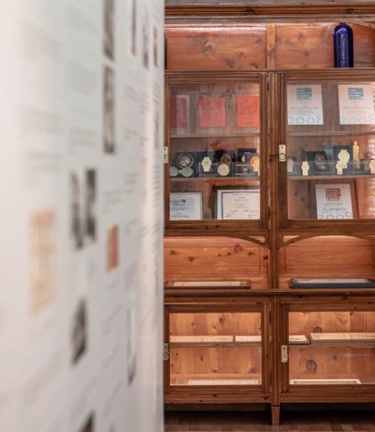
Founders’ Gallery
This gallery is a tribute to all founders and outstanding people who contributed to the Company’s growth. In addition to the three founders who started Sociedade Água de Luso, originally known as Sociedade para o Melhoramento dos Banhos de Luso: António Augusto da Costa Simões, Francisco António Diniz and Alexandre Assis Leão, is also Emygdio Júlio Navarro, Minister of Public Works, 1986, who played a key role in promoting tourism in Luso and Bussaco.
Although not represented in the Gallery, the Luso Foundation recognizes another two more individuals who were important in the history of this company:
- Fernando Baeta Bissaya Barreto Rosa – who worked for more than 40 years for Sociedade Água de Luso, as Clinical Director of Termas de Luso (1929-1930) and as Board Chairman (1930-1959)
- Messias Ferreira Baptista – shareholder and managing director of Sociedade da Água de Luso (1937-1970). Together with Bissaya Barreto, they drove and much contributed to the company’s development and growth, namely in the construction of Grande Hotel das Termas de Luso, purchase of Quinta do Cruzeiro and construction of the new Água de Luso industrial facilities.

Termas de Luso
1726 – We received the news in "Aquilégio Medicinal " (first inventory of Portuguese mineral waters), written by Dr. Francisco da Fonseca Henriques, of the existence of a "(...) hot waterhole, which has been named Bath ..."
Although therapeutic use of the "Bath" occurs only half a century later, Dr. Francisco da Fonseca Henriques immediately starts referring to the hot waterhole as therapeutic water, with medicinal powers.
1852 – While visiting Mata do Bussaco on April 28, D. Maria II donates 100$000 rs for the future facilities of Banhos de Luso.
At the initiative of Dr. António Augusto da Costa Simões, Dr. Francisco António Diniz and Dr. Alexandre Assis Leão, “Sociedade para o Melhoramento dos Banhos de Luso is founded on Augusto 29.
With the support of Queen D. Maria II, construction of the new thermal spa facilities begins later that year.
This new building comprised nine bath rooms each with two bathtubs, totaling eighteen bathtubs. These were lined with tiles and the taps "both for filling and emptying" were made from Vista Alegre porcelain. Among the purchased equipment were copper showers and a sauna still on display at the Núcleo Museológico.
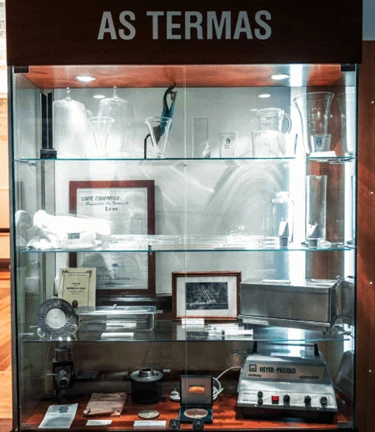
Grande Hotel de Luso
One of the most important events in the history of Sociedade da Água de Luso was the inauguration of Grande Hotel das Termas de Luso on July 27, 1940.
Designed by the famous Portuguese architect of that century, Cassiano Branco, Grande Hotel das Termas de Luso consisted of "(...) 7 floors, with a capacity for 200 rooms (80 with apartments), 2 lifts, reading, reception and smoking rooms, restaurant, a bar with large terraces, a barber, manicure and pedicure person".
The following year, on August 10, 1941, the hotel’s Piscina Monumental (Olympic pool) was inaugurated. The fact that the pool was an Olympic-size one, enabled Grande Hotel das Termas de Luso to host swimming tournaments, attracting national and international big names in this sport to Luso during the 40’s and 50’s.
On display at Núcleo Museológico are pieces used at the time in Grande Hotel das Termas de Luso, heritage of Sociedade da Água de Luso
